
Download Whitepaper
How to address gender pay gaps & create a successful pay equity strategy
The COVID-19 pandemic, along with gender and racial protests, has raised awareness of inequities in our culture. At the same time, our technical progress has increased our collection and analysis of compensation and employment data. New tools have made it easier to discover and assess pay disparities.
Legislators have taken notice and there has been an increase in pay equity and pay transparency laws. In 2023, California will require larger employers to report both demographic and pay data to the state.
Although pay equity laws have been around since the Equal Pay Act of 1963, the gender pay gap persists. Data shows that:
- Women continue to make less money than men for the same work.
- Race also matters, with Latina and Black women making even less.
- Geography plays a role: In Vermont women make 90% of what men make, in Wyoming, they make 65%.
- Education increases pay since higher paying jobs require additional degrees, licensing, and/or training.
- Age is also a factor in the gender pay gap; younger women make almost as much as men the same age, but the gap widens over time.
- Over a 40-year career making median incomes, a woman would make about $400,000 less than a man. A Latina would make $1 million less than a man over her career in the same job.
The gender pay gap exists in every profession in the U.S. Men make more than women for similar work in every type of job. And professions that are considered "women's work" like teaching and caring for children are some of the lowest paid, even though the work is essential, requires training, and is challenging.
It's time to understand the gender pay gap and begin to do something about it because it's the law and especially because it's the right thing to do for the future of women and the organizations that benefit from their work.
Pay equity violations are expensive
If you don't pay employees equally for equal work, you can violate:
- Title VII
- The Equal Pay Act
- Federal and State contractor requirements
- State employment discrimination laws
- State equal pay laws
- Salary history and transparency laws
If you get sued and lose, not only do you have to close the pay gap going forward, you also can be required to pay damages going back several years, penalties, and attorneys' fees. A willful violation of pay equity laws is also a crime with jail time up to six months.
The State of the Gender Pay Gap and Why Compensation Data Matters
The data has been there. Companies have always tracked labor costs and employee pay. But it's usually been a function of budget and resource allocation. Now, both state legislatures and organizations of all sizes are looking at the gender pay gap and taking steps to address it using compensation data.
At least 15 states and a dozen cities have enacted salary history bans, which make it illegal for employers to ask candidates what their past salary was.
"The goal is to prevent past pay gaps from carrying forward into a new role. Instead, employers should be paying competitive rates based on the market and their internal compensation strategy," said Lenna Turner, Salary.com's Director of DEI and a compensation consultant. “Now is the time companies should really look to develop a pay equity philosophy and strategy.”
Some new state and local pay transparency laws also require employers to disclose the pay range for the position in the job posting, upon request, or during the interview process.
"Pay disclosure laws force employers to determine the pay range for roles in advance and not decide compensation based on who the candidate is. This is important to address historic and systemic pay inequities between men and women, particularly women of color," Turner said.
California has taken it a step further to require employers to disclose to the state what the pay is in their organization by race/ethnicity, gender, and general occupation.
"As companies begin to understand the value and importance of tracking all kinds of HR data and we have developed new tools and software, it has never been easier to assess pay equity. This is not lost on regulators who are interested in improving pay equity and requiring employers to disclose pay," said Heather Bussing, a California employment attorney. "Before you start reporting your pay data, it's essential to understand what it says and to be addressing any pay equity issues."
Pay transparency is a big shift for many organizations, especially large companies with multiple locations where salary decisions are often made by hiring managers on a case-by-case basis.
"This leads to inconsistencies and can result in unconscious bias factoring into compensation,” Turner said. “When you combine this with historic gender and racial pay gaps, it makes progress on pay equity difficult."
The reality is that there has always been a gender pay gap. And there continues to be significant disparities in pay between men and women doing similar work, as well as barriers to advancement to higher paid positions for both women and people of color.
Understanding the nature and extent of the gender pay gap and having the pay data to assess and address it is the key to both pay equity and more consistent compensation practices.
What is the gender pay gap?
The gender pay gap is the difference between what men and women make for the same work.
In the U.S., women still earn about 83 cents for every dollar men make. This hasn't changed much over time. The chart below is the Bureau of Labor Statistics data on median weekly earnings from 2000 to the third quarter of 2022.
Source: Bureau of Labor Statistics
But it's not just earnings. The American Association of University Women have determined in 2020 that women have only 32% of the wealth that men have, only 70% of retirement funds (for those who have any) and also carry two-thirds of the nation's student debt.
Harvard Business Review recently published a July 2022 study of Massachusetts Bay Transportation Authority train operators. The workers are all union members and pay is negotiated by contract, removing most of the opportunities for gender bias. Nonetheless, women train operators made 89 cents for every dollar men made. The reason? Shifting schedules that made it hard for women to handle all the responsibilities they have outside of work, such as caring for children and taking elderly parents to doctor appointments. In particular, the opportunity for overtime shifts were unpredictable and available on short notice. Because women had additional (unpaid) obligations, they could not work the overtime shifts.
McKinsey looked at Women in the Workplace (October 2022) to explore women in leadership in 333 organizations that employ more than 12 million people.
Women are still underrepresented in leadership and the barriers for advancement continue–their judgment is questioned, they are mistaken for someone more junior, and they continue to have significant burdens outside of work.
"For every 100 men who are promoted from entry level to manager, only 87 women are promoted, and only 82 women of color are promoted. As a result, men significantly outnumber women at the manager level, and women can never catch up."
Women leaders are also leaving companies at an extraordinary rate. "For every woman at the director level who gets promoted to the next level, two women directors are choosing to leave their company."
This affects both organizations and the gender pay gap. When women, particularly women of color, cannot advance to higher paying leadership roles, the pay gap will continue.
History of the gender pay gap
Historically, the concept of the man as "breadwinner" comes from 19th Century England where economists asserted there was a necessary gender division where men were "producers" and women were dependent on men to support them. This meant that men's work was more important and more highly valued than women's work. Men needed to make more to support their families. If women worked, they were taking jobs from men who needed them.
Even when women entered the workforce during World War I because the men were fighting (and the work still had to be done), the women were forced to quit their jobs so men returning from the war could have them.
Many women could not own property until the mid-1800s. Women could not vote in U.S. elections until 1920. Even then, it was only white women. It wasn't until the women’s movement of the 1970s that women got some power to control their own finances and lives. Women could not get a credit card in their own name until 1974, could not serve on a jury in some states until 1975, and did not have protections against getting fired because they were pregnant until 1978. Sexual harassment did not become illegal until 1980, when it was recognized as a form of gender discrimination by the EEOC. The Supreme Court first recognized sexual harassment as a form of workplace discrimination in 1986.
While women have had legal rights and protections for more than 50 years, there still is a significant gender pay gap.
Current drivers of the gender pay gap
That women give birth and still do the majority of child rearing and household work is still a primary driver of income inequality between men and women.
Cultural assumptions that men should be paid more because they have families to support persist. The reality is that for 40% of U.S. households, women are the primary or sole earner.
Cultural biases about what kinds of jobs women should do persist, even though women make great construction workers, firefighters, engineers and especially CEOs.
Occupations that historically have been held by women, such as teaching, social work, and nursing, are often lower-paying jobs. But in those occupations, men still make more.
Even in jobs like accounting, where women make up more than 58% of the profession, the women are paid 80 cents for each dollar men earn.
How big is the gender pay gap?
On average in the U.S., women make 83 cents for every dollar men make for doing the same work. That means women effectively work 42 days a year without pay compared to their male colleagues. The gap compounds over time as companies give raises as a percent of existing wages. Over a 40-year career making median incomes, a woman would make $407,760 less than a man. A Latina would make $1,121,440 less than a man over her career in the same job.
The pay gap varies by state, occupation, age, and education levels.
Gender pay gap by state
Washington D.C., Vermont, and New York have the lowest gender wage gaps, with women earning 8.1% to 11.6% less than men. At the other end of the spectrum, Mississippi, Louisiana, Utah, and Wyoming have the largest gender wage gaps. Women in these states earn between 26.8% and 34.6% less than men. A woman in Wyoming makes 65 cents for every dollar a man makes.
Source: US Census Bureau
Here are the average earnings for men and women by state and the percentage women effectively are working for free because of the difference.

The city you work in can also make a difference in gender pay gap.
The American Association of University Women, looked at how much women earn compared to men in 25 major metro areas using 2019 U.S. Census data. The smallest wage gap is in Los Angeles, where women make approximately 90.6% of the median earnings for men, a pay gap of 9.4%. Detroit had the largest wage gap, where women make 73.8% of men's earnings, a pay gap of 26.2%.
Gender pay gap by race
Race makes a significant difference in wage gap. The racial breakdown of average women's earnings compared to men of the same race is:
- Asian: 71%
- White: 83%
- Black: 90%
- Latina: 86%
Source: U.S. Bureau of Labor Statistics
When you look at who makes the most money, the picture changes. On average, Asians have higher wages, although there is still a significant gender gap. Next is Whites, with Black and Latinx making the lowest wages.
And still, there is a gender gap.
Source: US Bureau of Labor Statistics
Here are women's equal pay days the number of extra days women have to work to make what men made in the year before. This means that Latinas and Indigenous women have to work 21-22 months to make the same income as a white man makes in 12 months.
White women – March 9
All women – March 24
Mothers – June 4
Black women – Aug. 3
Native-American women – Sept. 8
Latinas – Oct. 21
Further, the wage gap is not closing any time soon. The American Association of University Women's latest estimate of when the wage gap will close for women by race based on the current rate of progress is bleak. Black women will not see pay equity until 2369, and Latinas will have to wait almost 100 years longer – until 2451.
Gender pay gap by education
Having a college education also makes a huge difference in earnings for both men and women. People with a bachelor's degree or higher generally make more than twice than people who did not graduate from high school.
Source: US Bureau of Labor Statistics
Women have been steadily overtaking men in attainment of college degrees and have been the majority of college graduates for a decade.
Source: US Census Bureau
This is especially true for post-graduate degrees, with women earning substantially more advanced degrees than men since 2011.
Source: US Census Bureau
But it's not clear that more education or advanced degrees will close the wage gap. While education can increase women's wages, the pay gap actually widens with more education.
The Department of Labor reports that on average, most women with advanced degrees earn less than white men with only a bachelor's degree. The pay gap gets larger with education. Women with a doctorate earn 32% less than men with the same degrees. Women with a master’s degree make 29% less than their male counterparts.
Gender pay gap by occupation
One partial explanation for the differences in average earnings between men and women is that there are more women in lower-paid professions than men.
Women make up the majority of workers in the lowest-paying professions. Of the 20 lowest-paying professions, women are the majority in 15 (mostly domestic workers). Of the 20 highest-paying jobs, women are the majority in four (pharmacists, nurse practitioners, physician assistants, and veterinarians).
The 2021 data from the BLS shows that not much has changed with pay equity (even though a lot has changed in the world).
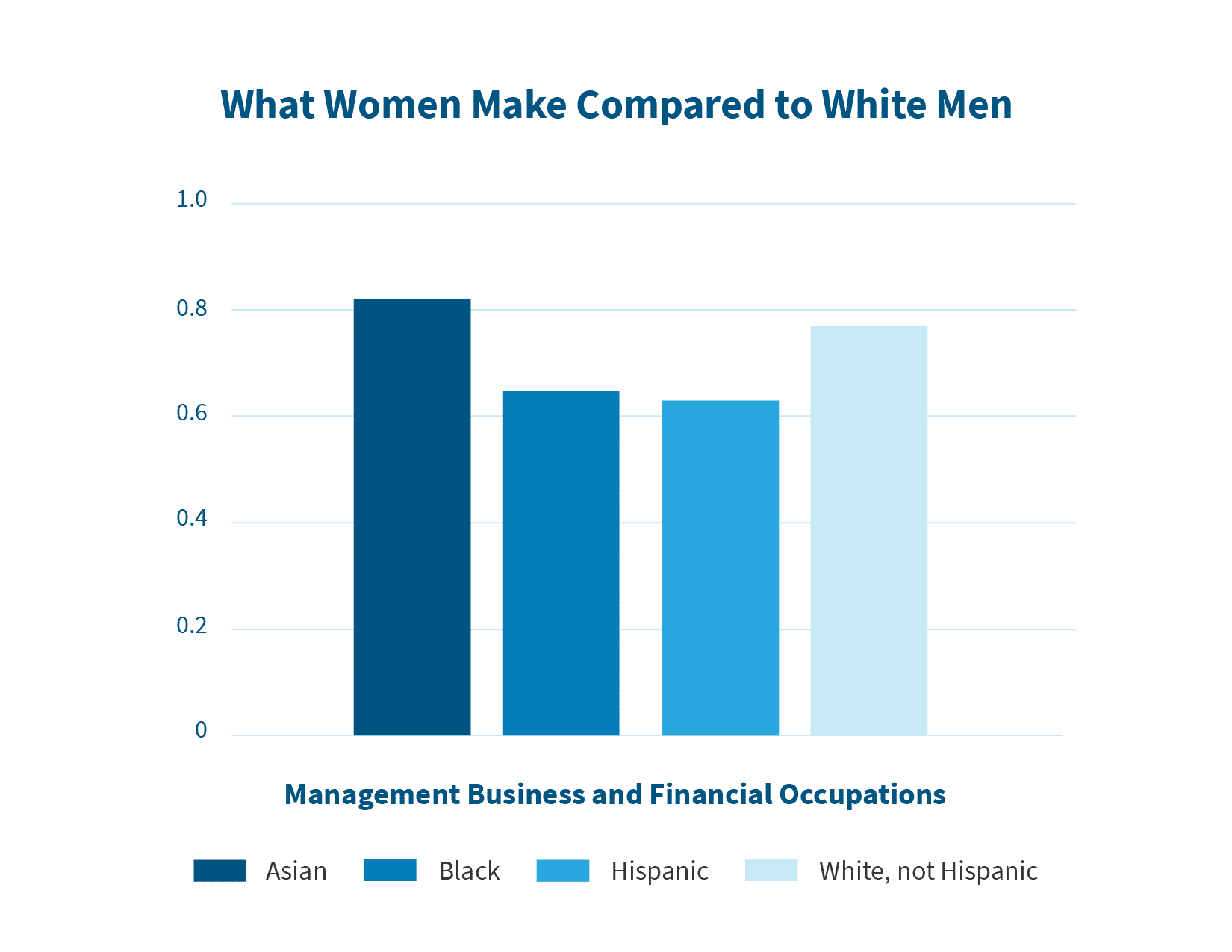
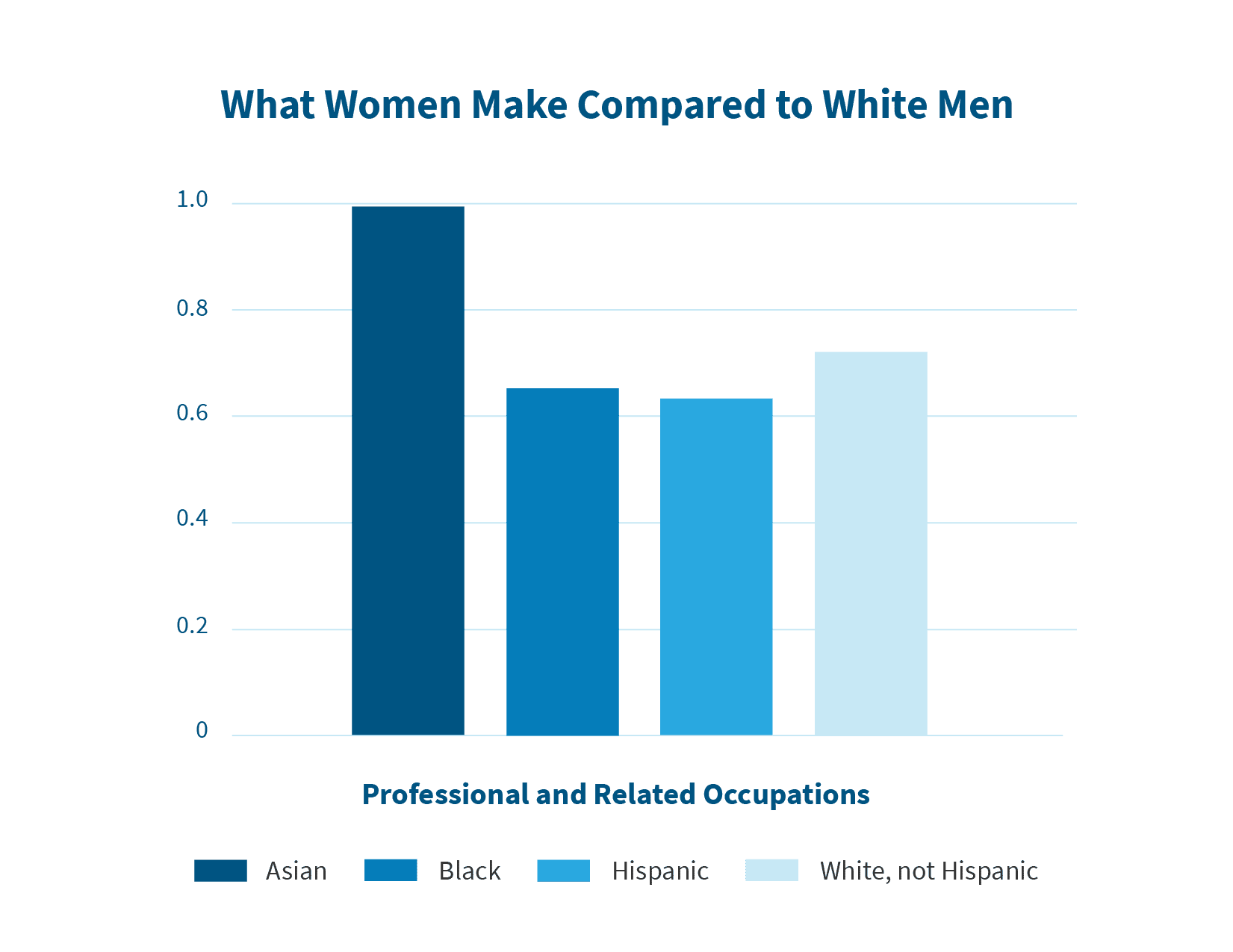
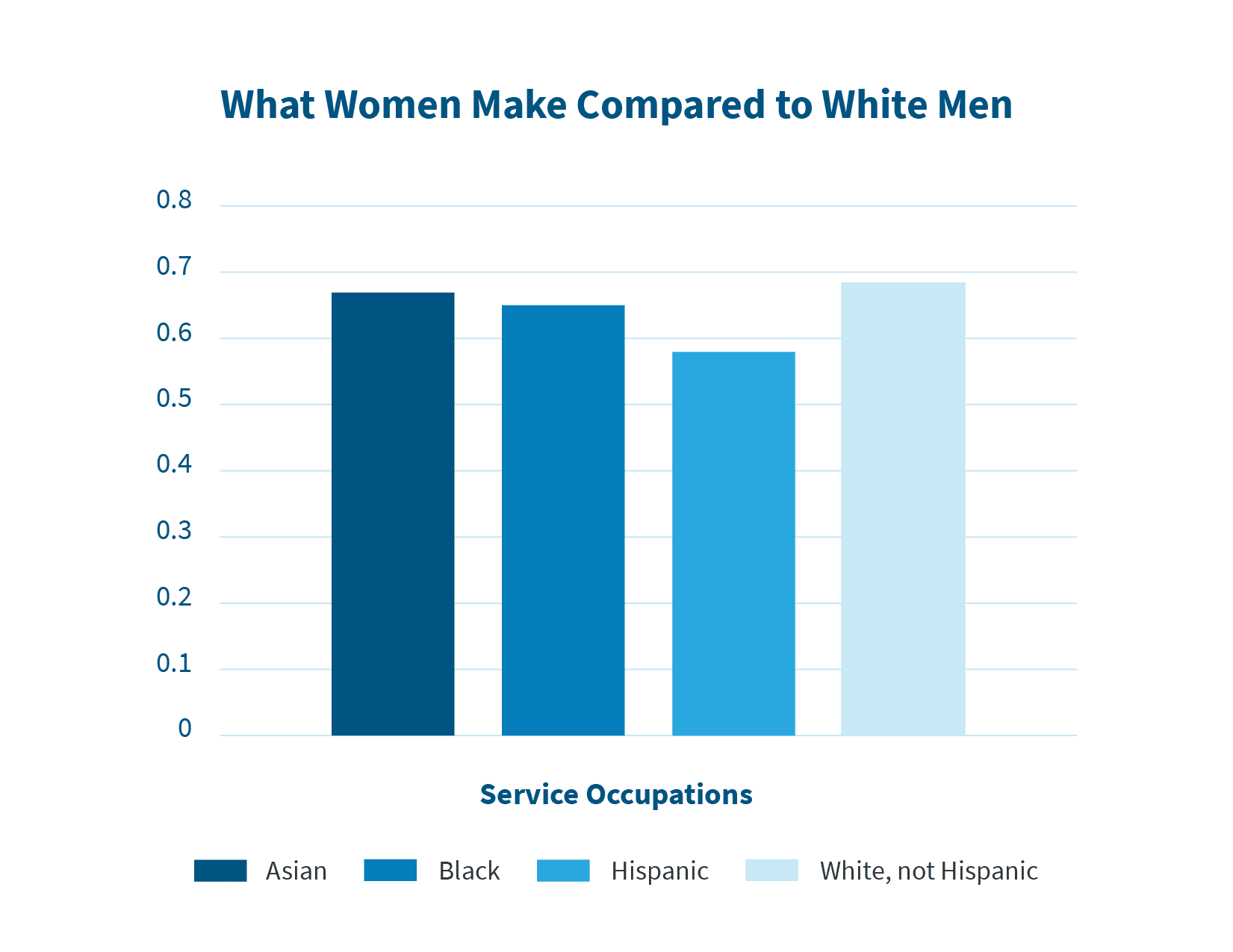
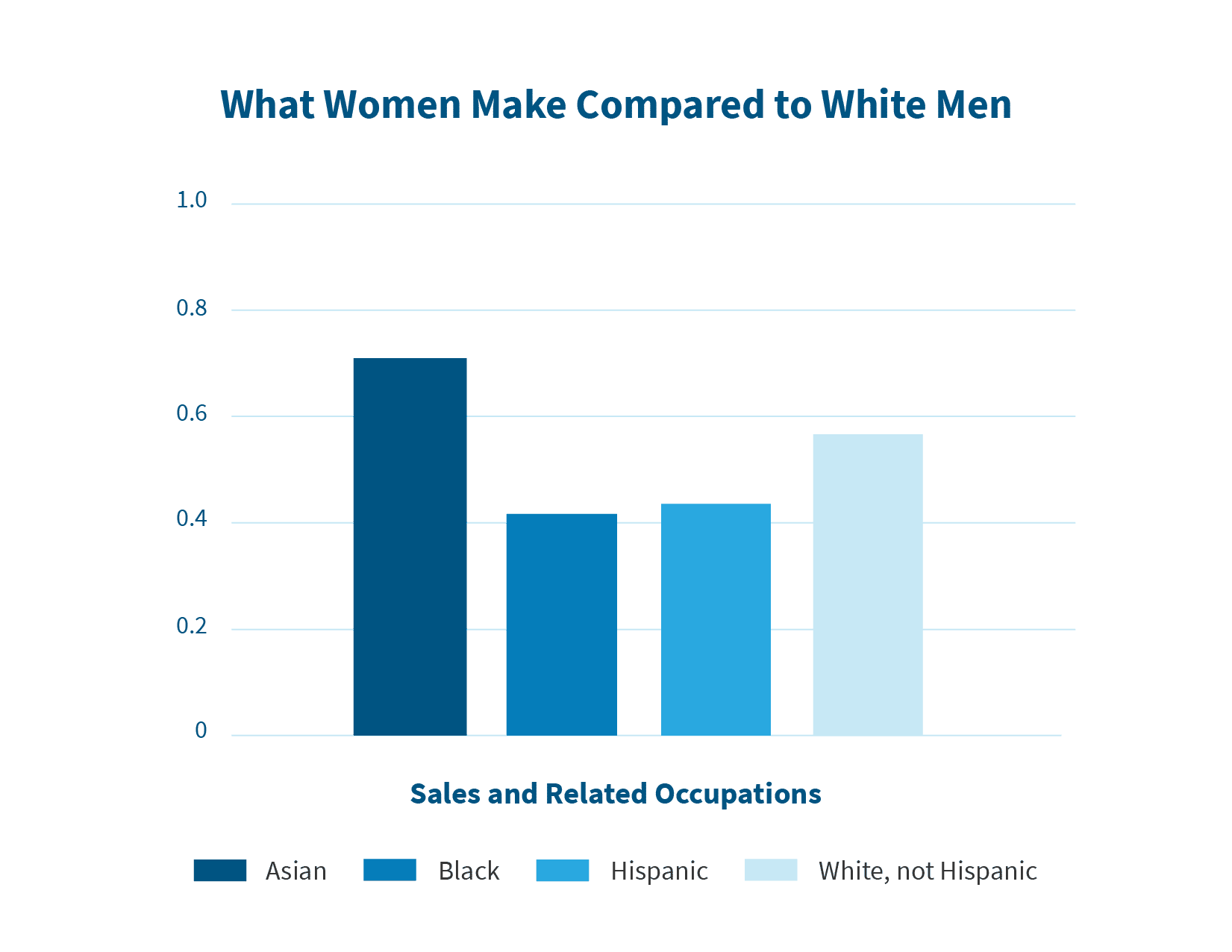

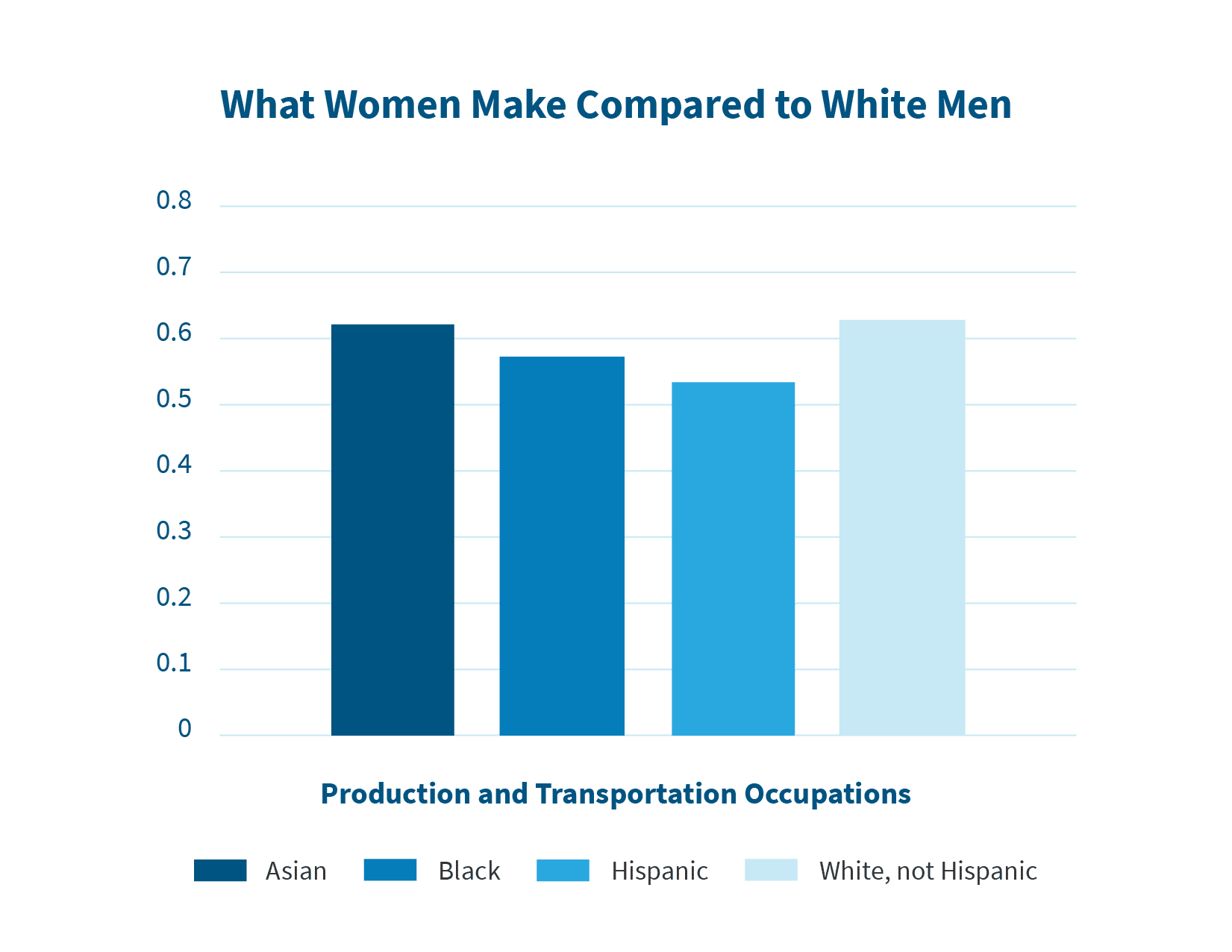
- Women teachers in the U.S. outnumber men roughly 3 to 1.
- Women nurses outnumber men by nearly 8 to 1, according to The Institute for Women’s Policy Research.
- Half of physicians are women, but they are overly represented in pediatrics and obstetrics and gynecology, which are among the lower-paying specialties.
- Women are less than a thirdof workers in science and engineering.
- Black women earned 24% of doctorates in STEM, but only 5% of managerial jobs in STEMwere held by Black women and men combined.
There are only five jobs where women generally make more than men. Only pharmacists are in the top-paying professions.
- Compliance officers
- Graphic designers
- Clinical laboratory technologists and technicians
- Pharmacists
- Insurance claims and policy processing clerks
The professions with the largest pay gaps are:
Even though gender pay equity has been federal law since 1963, even the lawyers are still paying women 60 cents for every dollar men make.
Gender pay gap by age
Pay inequities also increase with age.
Source: Bureau of Labor Statistics
At 24, women make 11% less than men. By 44, they make 17% less. And by 54, they make 24% less.
While young women start out just slightly under young men, the gap increases over time. In addition to occupation, race, and location, this is due to wage increases as a percentage of existing pay, women with young children being able to work less, and bias.
Using compensation data to solve the gender pay gap
The good news is that addressing pay gaps is straightforward. It involves bringing lower-paid employees into the existing pay ranges for their roles.
To address potential pay gaps, start with a pay equity audit. A pay equity audit should identify pay gaps that can be statistically correlated to gender, race, or other protected classes. This allows you to see where potential issues exist and analyze whether the differences in pay are based on legitimate business reasons or reflect bias.
Because women and people of color have historically made less than white men in almost every occupation, almost every organization will find they have some pay equity issues.
As you prepare to do your pay equity audit, here are the steps to take to analyze and address any potential pay gaps uncovered by the audit.
- Better call legal
You want your employment lawyer involved with the audit to protect the confidentiality of the pay equity audit and analysis. You most definitely want your lawyer to help you assess and resolve any pay equity issues. This is also to maintain privilege and confidentiality. But mostly, it's to get advice on how to analyze the issue, the risk, and potential solutions.
- Assess whether it's discrimination
The results of a pay equity audit will usually identify statistical correlations between pay and members of a protected class. It tells you where women and people of color are paid less than others doing similar work. It does not tell you why. And correlation is not causation.
To figure out whether the pay gaps are potential discrimination or can be justified based on legitimate business factors, you have to look at both the work and the individuals doing the work.
Work is comparable for pay equity when it requires similar skills, effort, and responsibility and is done under similar working conditions. This is where you double check whether you grouped comparable jobs correctly. For example, if you are paying your lab scientists in the Antarctic significantly more than the scientists in Albuquerque, it likely has to do with the working conditions. And if you are paying your tech assistants differently, look at whether they are required to do calculus or make copies.
If the work is basically comparable (it won't ever be a perfect fit), next look at the people doing the work. See if the pay gap is related to specific skills, training, qualifications, certifications, or another factor that would justify paying one person more. This can include geographic and cost-of-living differences and significant differences in experience or performance.
It's a judgment call. But unless there is some factor that really stands out so that the reason for the pay gap is obvious, it's probably better to address the pay gap.
- Close the pay gap
When you close the pay gap, you eliminate the risk and don't have to spend any more time, stress, or legal fees trying to assess or justify the differences in things that are already hard to compare – like people and their work.
If you are using software that helps assess pay equity, it will probably give you the amounts it will take to close the pay gaps you find.
It's a good idea to see the costs involved before you spend too much time and money trying to justify the gaps. It may be less expensive to simply close the gaps if the work and people doing it are generally comparable.
To close the pay gap, you pay the people who are making less more so that their pay is in the same general range as the other people doing similar work. There is some room for give and take here within the range. The important thing is that it makes business sense to pay one person more than the other based on their skills, experience, and differences between the actual work.
Look at your salary ranges for the roles. Benchmark what other organizations are paying for similar roles. Then try on possible solutions and rerun your pay equity analysis to see if it solves the issue.
- What if we can't afford the fix?
If your budget can't handle closing all the pay gaps for all the people who need it closed, find the best solution you can afford and have a plan and timeline to correct the issues as soon as it's feasible.
There are two important rules to remember when dealing with pay equity. 1. Affordability and budget are not a defense to a discriminatory pay gap; and 2. you can only raise someone's salary to address pay equity issues; you cannot lower anyone's pay to make things equal.
If your pay equity issue looks bigger than your budget, turn to the friendly employment lawyer who has been guiding you through this and ask for her help in crafting the best approach. You need a plan to fix it and do as much as you can as quickly as you can.
Some states, like Massachusetts and Rhode Island, have a safe harbor period where you have a set amount of time after a claim is made to correct pay gaps without liability. This is a great approach and encourages employers to assess and correct pay equity, which is the point of the laws in the first place.
- What if we need more help figuring it out?
Compensation management is hard. Every person is different, every job is different, and every organization is different. If it looks like your compensation strategy could use an overhaul, it might be time to seek professional guidance. An experienced and knowledgeable compensation consultant can help you sort it out and put a great framework in place.
- Tracking and reporting
Going forward, stay on top of pay equity by tracking your data, understanding the market, and staying competitive while eliminating pay gaps. It's much better to maintain pay equity than to periodically correct it because someone brought a claim.
- Pay equity is for everyone
While pay equity laws are there to address pay gaps based on gender and race, everyone deserves equal pay for equal work. By understanding and monitoring pay equity gaps, you will also catch any disparities between the worker who has been there several years and the new guy with the same experience and qualifications who comes in at a higher salary. Turnover is expensive. Don't let pay inequities cause your best people to leave.
- Get pay equity right
Pay equity is about more than compliance and money. It's about fairness and valuing people for their work and abilities instead of who they are or what they look like. Pay equity is an essential part of creating an inclusive culture where people want to come to work and stay.
It's in everyone's best interest to get pay equity right.
See how to transform your organization’s pay equity strategy with a personalized demo of Salary.com CompAnalyst Pay Equity Suite.
Or schedule a free consult with one of our Pay Equity experts.




